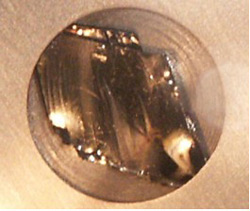Uranium Atoms Don’t Share the Vibe
Suppose you throw a rock into a pond, but instead of circular waves spreading across the surface, only a single bit of the surface at the rock’s entry point oscillates up and down continuously. In the 31 March PRL researchers report an equally surprising effect in a crystalline solid: a few-atom-wide vibration that refuses to spread through the material. The team probed heated uranium with x rays and neutrons to study the crystal’s vibrations. Although predicted twenty years ago, the effect has never been conclusively seen in a three-dimensional crystal. The result seems to demonstrate the surprising ability of a uniform material to concentrate energy spontaneously.
Atoms in a crystal are like a series of blocks connected to their neighbors by springs. Bump one block, and it ordinarily sends jitters through all of its neighbors. But if an atom swings back and forth far enough, its natural frequency can change dramatically, so that neighboring atoms may no longer resonate in lockstep. The effect is called nonlinearity, and researchers have predicted that it should lead to long-lasting vibrations of one or a few atoms called intrinsically localized modes, or ILMs.
All crystals display some nonlinearity at high enough temperatures, but ILMs had only shown up clearly in one- or two-dimensional systems. Uranium crystals seem to contain many ILMs if heated past 450 degrees Kelvin, according to Michael Manley of Los Alamos National Laboratory in New Mexico and the University of California at Davis and his colleagues. “These sort of things should exist all over the place in materials; it’s just really hard to see them,” says Manley. The effect is noticeable in uranium, he believes, because the atoms have an additional source of nonlinearity compared with most other elements. The atoms’ vibrational energy can be exchanged with the energy of their outermost electrons, which affects the springy restoring force they feel as they rock to and fro.
To catalog uranium’s variety of vibrations, or phonons, the team probed crystals with beams of neutrons or x-ray photons. The particles create or absorb vibrational energy in the crystal, so by measuring their scattering properties, the researchers could reconstruct the phonon properties. The data showed a surprising amount of energy in a phonon whose wavelength was as small as the spacing between uranium atoms in the crystal. And the energy in this phonon increased with temperature much more dramatically than would be expected for an ordinary phonon. The team believes these and other indications suggest vibrations perhaps two to three atoms wide.
Interpreting the data as a smattering of ILMs explains previous uranium puzzles, Manley says. When a material is bent or compressed, defects in the crystal structure are normally forced to move. But they may not pass through the vibrating region of an ILM so easily, which could explain why uranium loses ductility when heated. “There’s all kinds of new physics related to having these things,” says Manley.
The idea of an ILM “is cool because you have a localized state in a system without any imperfections” to focus it, says Sergej Flach of the Max Planck Institute for Complex Physical Systems in Dresden. “And 3-D is especially interesting because it is the real world.” But he will be more convinced by the finding after other interpretations of the data are more conclusively ruled out. Some of the measurements are “particularly convincing,” says Al Sievers of Cornell University, one of those who first predicted three-dimensional localized modes. “Previous sightings have involved complex indirect arguments.”
–JR Minkel
JR Minkel is a freelance science writer in New York City.





